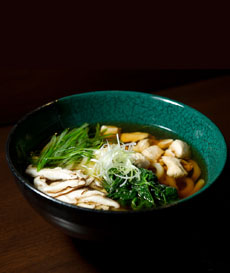TIP OF THE DAY: Homemade Ramen Noodle Soup

Homemade ramen soup Photo courtesy |
Packaged ramen soups are popular with some people because they’re inexpensive yet tasty. And salty. There’s much more much salt in packaged ramen soups than is good for you. One label we checked had 1434mg of sodium which is 60% of your Daily Value of salt; and if you eat the whole package (two servings), you’ve exceeded your Daily Value.* So here’s an easy solution: Make your own ramen soup. It’s easy, and you can make as large a batch as you like. It’s also a great catch-all for leftover pasta, meats and veggies. Just follow this recipe template: Choose Your Base Buy beef, chicken or vegetable broth or stock, preferably low sodium. If you like to make your own stock, by all means, use it. If you find yourself with pork bones, make pork stock. Taste your stock; if it needs a bit more salt, use low sodium soy sauce. |
|
|
Choose Your Ramen (Pasta) You can select any pasta width or shape, from slender angel hair to flat fettuccine to round spaghetti or spaghettini. There’s no reason why you can’t use very wide pasta, like papparadelle, or nonwheat pasta such as rice noodles or cellophane noodles. (See our Pasta Glossary for the different types of pasta). Even though ramen is a noodle soup, if you’re carb counting, you can leave out the pasta altogether and add more veggies. |
||
|
Choose Your Protein Protein is one of the standard ramen toppings, but we like to break it out from the vegetable toppings. As mentioned earlier, ramen soup is a great way to use leftovers: cooked ground meat; fish or seafood including sliced fish cake (kamaboko, a type of surimi, Japanese processed seafood that includes imitation crab leg); sliced beef, lamb or pork; a soft- or hard-cooked egg or tofu. Customize the recipe to your preferences (every recipe!). There’s no reason that you can’t use a combination of proteins. Choose Your Toppings You’re the cook and the consumer, so add whatever toppings appeal to you. Consider bamboo shoots, bean sprouts, bell pepper, cabbage, corn, mushrooms, pickled ginger or plums, seaweed or spinach and thin-sliced scallions. |
 Get artistic with your toppings. Photo courtesy Haru Restaurant | NYC. |
|
|
Any cooked or raw vegetable that appeals to you can become a soup topping. You’ve got leftover broccoli? Toss it in! Choose Your Seasonings We feel strongly about adding fresh herbs to every dish. For Asian soups, we particularly like basil and lemongrass, but don’t leave out the parsley that’s hanging out in the produce drawer. If you like heat, add thin-sliced of your favorite chile. For more depth of flavor in the broth, add a spoonful of miso paste. Add Some Color We also like a touch of color to every dish. While it isn’t traditional, try a garnish of finely-diced red bell pepper or hot red chile. Ramen is a Japanese noodle dish made with Chinese-style wheat noodles (as opposed to rice noodles), served in a meat- or fish-based broth. It’s a meal in a bowl, often enjoyed for lunch. Toppings vary widely based on local preferences. Every region in Japan has its own variation of ramen, from the tonkotsu (pork bone broth) ramen of Kyushu, Japan’s southernmost prefecture, to the miso ramen of Hokkaido at the opposite end of the archipelago. Ramen is of Chinese origin, but there is debate over the etymology of the word. One of several theories is that ramen is the Japanese pronunciation of the Chinese word lamian, meaning “hand-pulled noodles.” *Daily Value nutrient targets, set by the government, vary by age, gender and calorie intake. For adults under 50, the Daily Value for sodium is 2300 mg/day. As long as we’re on the topic, other DVs to watch include cholesterol, 300 mg/day; fiber, 25 g/day for women, 38 g/day for men; saturated fat, 10% of total calorie intake. It is worth noting that for sodium, cholesterol and saturated fat, eating less than the DV is beneficial; for fiber, eating more is beneficial.
|
||